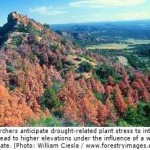
Oakland, California, USA – Global Footprint Network, a California-based environmental research organization, calculates nature’s supply in the form of Biocapacity, the amount of resources the planet regenerates each year, and compares that to human demand: the amount it takes to produce all the living resources we consume and absorb our carbon dioxide emissions. Its data reveal that, as of August 21, humanity will have demanded all the ecological services – from filtering CO2 to producing the raw materials for food – that nature can provide this year.
From now until the end of the year, we will meet our ecological demand by depleting resource stocks and accumulating greenhouse gases in the atmosphere.
“If you spent your entire annual income in nine months, you would probably be extremely concerned,” said Global Footprint Network President Mathis Wackernagel. “The situation is no less dire when it comes to our ecological budget. Climate change, biodiversity loss, deforestation, water and food shortages – these are all clear signs that we can no longer finance our consumption on credit. Nature is foreclosing.”
What is Ecological Overshoot?
For most of human history, humanity has been able to live off of nature’s interest – consuming resources and producing carbon dioxide at a rate lower than what the planet was able to regenerate and reabsorb each year.
But approximately three decades ago, we crossed a critical threshold, and the rate of human demand for ecological services began to outpace the rate at which nature could provide them. This gap between demand and supply – known as Ecological Overshoot – has grown steadily each year. It now takes one year and six months to regenerate the resources that humanity requires in one year.
Addressing Carbon Key to Balancing the Budget
Climate change is perhaps the most prominent sign of our ecological overspending. Our Carbon Footprint (as calculated by Global Footprint Network, the amount of land and sea area it would take to absorb all the CO2 we emit) is the biggest part of humanity’s Ecological Footprint, and is by far the fastest-growing. Our Carbon Footprint has more than doubled since 1970. During that time, it has increased at a rate more than three-times faster than the next-fastest growing portion of humanity’s footprint, built-up land. Carbon dioxide emissions now account for over half of human demand on nature. We are now emitting much more carbon dioxide than the natural ecosystems of the planet can absorb; thus, it is building up in the atmosphere and contributing to climate change.
How Earth Overshoot Day is Calculated
Every year, Global Footprint Network calculates humanity’s Ecological Footprint – the amount of productive land and sea area required to produce the resources we consume and absorb our waste, including CO2 emissions – and compares that with biocapacity, the ability of ecosystems to regenerate resources. Earth Overshoot Day, a concept devised by U.K.-based New Economics Foundation, is calculated from 2007 data (the most recent year for which data are available) and projections based on historical rates of growth in population and consumption, as well as the historical link between world GDP and resource demand.
Last year, Earth Overshoot Day was observed on September 25, 2009. This year, overshoot day is estimated to come more than a month earlier in the year. This is not due to a sudden change in human demand, but rather to improvements in the calculation methodology that enable us to more adequately capture the extent of overshoot. (For example, our latest data show the world has less biocapacity available, primarily in the area of grazing land, than previously estimated.)
“We would expect our estimates of overshoot to be, if anything, conservative,” Wackernagel said. “We know we are far from living within the means of one planet. The good news is much of the technology we have to begin to address this problem is available and it is open source: things like compact urban design, energy-efficient housing, ecological tax reform, removal of resource subsidies, safe and affordable family planning, bicycles, low-meat diets, and life-cycle costing.”
To learn more about Earth Overshoot Day, visit: http://www.footprintnetwork.org/earthovershootday
To calculate your own Personal Ecological Footprint, and learn what you can do to reduce it, visit:
About Global Footprint Network
Global Footprint Network is an environmental research organization working to advance sustainability through use of the Ecological Footprint, a resource accounting tool that measures how much nature we have, how much we use and who uses what. Global Footprint Network and its international partner network is focused on solving the problem of overshoot, working with businesses and government leaders around the world to make ecological limits a central part of decision-making everywhere. For more information, visit www.footprintnetwork.org.
Source: WWF.













